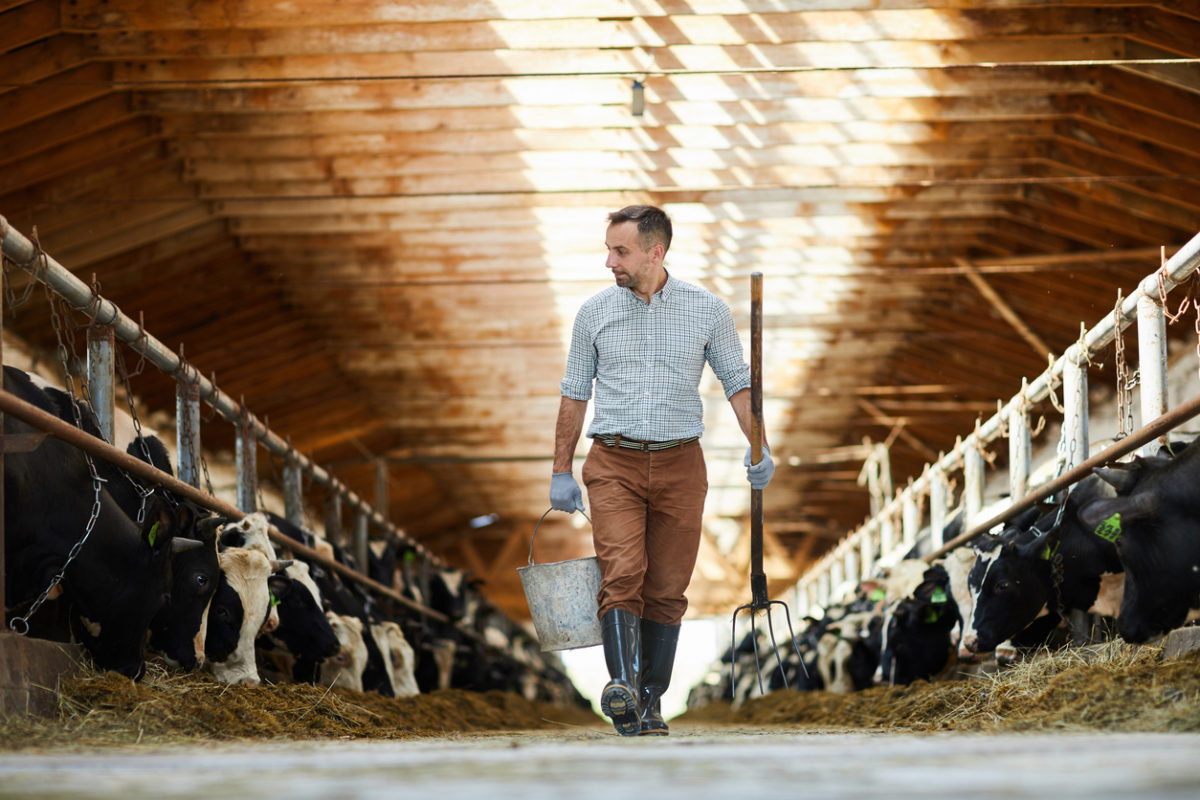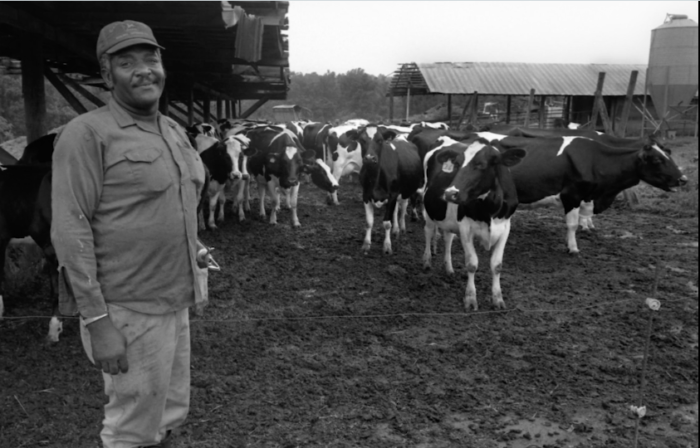Civil Eats: Is the Second Farm Crisis Upon Us?
by Siena Chrisman, FARMING, Food Policy, Rural Environment and Agriculture Project | September 10, 2018
Farmers across the country are in a state of emergency with dairy and grain producers, new farmers, and farmers of color being hit the hardest.
Joe Schroeder works as a farm advocate for Farm Aid, where he answers calls to the group’s farmer hotline. The calls, which are up 30 percent over last year, range from routine questions about navigating federal programs and exploring credit options to dire pleas for help from farmers who have run out of ways to keep their businesses solvent. He has heard from three or four suicidal farmers each month this summer.
Schroeder talks callers in crisis through Chapter 12 bankruptcy and sends out $500 checks to help them buy groceries and get the lights turned back on. One woman who called was eating nothing but frozen hamburger. Many families have had their electricity turned off, including one farmer who relies on an oxygen tank. Schroeder appealed to the electric company on his behalf, but the head of finance refused to work with them. The family could get him to the hospital if necessary, the farmer’s wife told Schroeder, because they had hidden their car in a barn nearby to keep it from being repossessed. Schroeder hasn’t been able to check in with the family since late July because their phone was disconnected.
Schroeder, who has been a farm advocate for nearly a decade, says the calls now are more desperate than they were even a year ago, when he started at Farm Aid. “They’re more complicated situations. People are calling us when it’s too late [to save their operations],” he says. He can offer help to many farmers, but what was once a robust network of state-funded farmer advocates has shrunk dramatically, leaving those remaining with more limited tools. “There are not many witnesses to this [crisis],” he says and sometimes simply being a witness is all he can do.
These are not isolated stories. As early as February 2018, the U.S. Department of Agriculture (USDA) predicted a decline in net farm income to its lowest level since 2002 (adjusted for inflation), with median farm income projected at negative $1,316. For well over a year, worries about a new farm crisis have rippled across rural America. The very term is synonymous with the 1980s, when the bottom dropped out of the agricultural economy, sending thousands of farms into foreclosure and shuttering businesses.
Grain and dairy farmers were beginning to see a repeat of the ‘80s as their prices dropped this spring—and then President Trump started a trade war. Retaliatory agricultural tariffs have kicked this new farm crisis into high gear. The president is offering $12 billion in farm aid to ease the pain, but neither those payments nor the farm bill being hammered out in Congress will substantially change the outlook for farm country. Ever since federal farm policy told farmers to “get big or get out” in the ‘70s, the push toward consolidation has created decades of slow-burning crisis for many farmers. The problem has some rural residents re-envisioning rural policy from the ground up.
Dairy and Grain at the Epicenter
The first half of this decade was a “golden period” for farmers growing commodity crops like corn and soybeans. Yields were up, prices reached record highs, and many farmers made long-overdue repairs or bought new equipment. For some, this meant accruing debt that weighs heavily now that crop prices have plummeted. And plummet they have: Soybean prices have fallen 19 percent since early May, to a 10-year low, and corn is now down more than 15 percent.
Tom Giessel grows corn, wheat, and grain sorghum on 4,000 acres in Central Kansas. “It’s a real mess right now,” he said in early June, even before the tariffs began. “It’s across the country… People try to be upbeat, but I’m starting to hear it everywhere.” He points to a looming problem of excess grain from last year that he suspects will make prices drop even lower for the 2018 harvest, especially with a tightened export market.
Both grain and dairy farmers rely heavily on loans to operate, borrowing early in the season for seed and other inputs and paying it down when they sell their harvest. The unpredictability of yields and prices can make the whole endeavor feel like a gamble, especially for farmers carrying additional debt. An emergency expense or several years of low prices can be catastrophic.
Farm Aid’s Schroeder says a lot of operations “can’t even get two years of bad luck without losing the farm.” As lending institutions have begun to deny operating loans or require more collateral than they have in recent years while prices show no sign of improving, many farmers are finding their luck is running out.
For dairy farmers, facing a fourth straight year of prices below the cost of production, bad luck has become an apocalypse. Pennsylvania farmer Brenda Cochran describes the uncertainty and stress on her dairy farm as a “war situation.” She compares it to being asked to “walk through a minefield with a baby on your hip.”
A gallon of milk costs a farmer approximately $1.90 to produce, but in the last year, farmers have been receiving as little as $1.35 per gallon. With prices so low, Cochran wonders how to pay for seed corn, feed, potential visits from the veterinarian, and health care for her ill husband. Ultimately, she wonders, “What is tomorrow going to hold for us? Can we go through another season?”
Many have decided they cannot. The USDA reported in January that the number of dairy farms had dropped to just over 40,000, a 3 percent decline in just a year. In total, around 17,000 dairy farms have closed in the last decade. But the last several months have gotten even worse: in Wisconsin, 382 dairy farms have sold out since January, a 30 percent jump from the same period last year. Trends are similar in other dairy states.
Even as the number of dairy farms shrinks, the milk supply continues to grow as the remaining farms get ever larger. In 1987, half of American dairy farms had 80 cows or fewer; by 2012, that number was 900 cows. In March, Walmart announced plans to open its own bottling plant in Indiana, leading Dean Foods, a major Walmart supplier, to terminate its contracts with over 100 dairy farmers in eight states. Processors in Wisconsin and New York have also recently ended farmer contracts. In an interview with Food Business News at the time, Dean Foods CEO Ralph Scozzafava said the company expected to “consolidate our supply chain by a meaningful amount over the next 18 to 24 months.”
That’s just what many farmers fear. Some regions only have one processor; if it terminates a farmer’s contract, the farmer is left with nowhere to sell their milk and few options other than selling off their cows.
It’s like “we are suffering from post-traumatic stress disorder that never gets ‘post,’” says Cochran. “I sit with my family and we jiggle, we’re so nervous. We’re paralyzed with anxiety.”
In a much-publicized move earlier this year, dairy cooperative Agri-Mark included suicide hotline information along with farmer milk checks. A Guardian report on U.S. farmer suicides in the U.S. brought the issue further into the spotlight. The report referenced a Centers for Disease Control study whose finding on the rate of farmer suicide has since been retracted, but the picture of rural hardship and depression remains accurate. “When there are no more options, it’s like a barren landscape,” says Schroeder. “You can’t even see that there might be a way forward.”

Shuttered downtown districts—like this one in Illiopolis, Illinois—are a common side effect of the ongoing move away from farming. Photo by Randy von Liski.
The Consequences of ‘Fencerow to Fencerow’
Farming is inherently a risky business, but it hasn’t always been this precarious. For more than 60 years, federal farm policy controlled commodity production and stabilized prices for both farmers and consumers in a system known as supply management. The arrangement ensured a floor price for farmers—essentially a safety net—and kept them from overproduction that would cause their prices to drop. But moves toward a more free-market approach, exemplified by former Secretary of Agriculture Earl Butz’ call for planting “fencerow to fencerow,” encouraged farmers to produce as much as possible, relying on direct payments and other government subsidies to make up for the low prices that followed.
Stephen Carpenter is an attorney with the Minnesota-based Farmers’ Legal Action Group (FLAG), a nonprofit law firm that works on behalf of family farmers that has seen foreclosures, repossessions, and bankruptcies become its clients’ top issues.
“Agriculture is sort of like the rest of the U.S. economy in terms of income and asset inequality—except more so,” he explains. With the focus on production and no safety net, smaller farms have sold out and relatively few big farms have expanded. In 2015, about 65,300 farms making over $1 million in gross income accounted for 51 percent of the value of all U.S. agricultural production. At the other end, the nearly 1 million farms making under $10,000 accounted for just 1 percent of production. As farms have consolidated and turned to technology to replace human labor, jobs have dried up, rural communities have shrunk, and isolation has grown.
While the big farms have been able to absorb losses and weather ups and downs—at least until recently—the many farmers who have not gotten big or gotten out have struggled day-to-day for decades. Seventy percent of farmers make less than a quarter of their income from farming and only 46 percent have positive net income from their operations.
‘The Struggle is What We Do’
Many farmers of color and young farmers have been hit especially hard.
“Black farmers haven’t gotten out of a crisis since Reconstruction,” says Jerry Pennick, who has spent 40 years with the Federation of Southern Cooperatives/Land Assistance Fund in Georgia, providing technical assistance to farmers across the South. He points to decades of documented discrimination by USDA, farm bills that virtually ignore the needs of Black farmers, and both structural and individual racism. “The struggle is what we do and who we are,” he says.
In 1920, there were 925,000 Black farm operators; the 2012 agricultural census counts fewer than 45,000, operating just .4 percent of all farmland. Eighty-six percent had fewer than 180 acres, and 79 percent had sales of under $10,000. Millions of farmers of all races have been pushed off their land in the last century, but while white-owned farms have declined by about half, Black-owned operations stand at 6 percent of their peak.
Black farmers were dispossessed not only by discriminatory lending, but by acts of racial intimidation and terror. Many rural Black Southerners fled violence when they moved to northern states as part of the Great Migration; the land they left was often folded into the assets of white neighbors. The repercussions are stark: low rates of historical Black property ownership are a key cause of today’s massive wealth gap.
Many white farmers in the south are also not thriving. Pennick believes until they realize “we’re better off working together than separately and put their own prejudices aside… the white small farmers are not really going to progress.” But even now that another crisis has begun to hit white farmers hard for the first time in a while, it’s not clear whether they’ll finally be willing to work with their Black neighbors on initiatives to benefit all small farmers—especially if they see any of the $12 billion farm bailout. He adds that many white farmers “are more concerned with maintaining white supremacy than equity within the farm community.”
Pennick acknowledges that shifting this dynamic would require a heavy lift, but maintains that it is increasingly important. As lenders tighten credit for large-scale farmers, the effects of this latest crisis will trickle down to hit small-scale diversified farmers. Across race, these farmers, who produce goods other than commodities, don’t have much cushion, making them more vulnerable to any changes in the farm economy.
The numbers of these farmers are large, but their income—and the number of calories they produce—is very small: half of all farmers have sales under $10,000 and 75 percent sell less than $50,000 a year. These are the folks who sell at farmers’ markets and work off-farm jobs to make ends meet; they are young or beginning farmers, including those without a farming background. Although they rely less on credit, Stephen Carpenter of FLAG says they’re coming to him in growing numbers, asking for legal help.
“Things seem to be squeezed all over,” says Carpenter. “I think people would be shocked the extent to which the farmers at their farmers’ market … are in or near poverty.”
Alyssa Dunn raises beef cattle in northeastern Iowa and is president of the state’s National Young Farmers Coalition (NYFC) chapter. The problems her corn and soy-growing neighbors are facing with low commodity prices feel remote to the young farmers she works with who are growing vegetables or small ruminants. But, she says, “We’re all struggling.”
In Iowa, high land costs are a challenge across the board; whether a farmer needs five acres for intensive vegetable growing or 1,000 acres for corn and soybeans, prices averaging $7,300 per acre but with spikes to twice that are prohibitive. For small operations, one-size-fits-all government regulations and the loss of local livestock infrastructure and markets add cost and can limit opportunity.
NYFC also identifies student loan debt and lack of access to health care as additional burdens on young farmers. Finally, fruits and vegetables, which the USDA calls “specialty crops,” are not eligible for government support payments, while both produce and animals are more labor-intensive to grow on a small scale with sustainable practices than on a large-scale conventional farm. “We have to ask [our customers] for a lot more than people are accustomed to paying,” Dunn says, making it difficult to build a stable market.
Thirty Years of Consolidation
In the definitive farm crisis of the 1980s, over 500 farms a week shuttered, their land sold to larger operations. Main Streets and manufacturers closed down and towns hollowed out. The decade fundamentally altered the landscape of rural America, with cultural, economic, and political repercussions still felt today.
Is today’s crisis is as bad as the 1980s? It depends who you ask. While some of the proximate causes are different, it’s clear that many of the results are the same: larger farms; fewer farm owners, community institutions, and jobs; more drug addiction and poverty.
Many of the farms that have survived since the 1980s bought their neighbors’ farms, paid off debt over decades, and used every tool available to keep going. Now even these long-time survivors are at risk and they worry about what will follow.
Barb Kalbach, who farms with her husband west of Des Moines, is one of these. Now, they’re thinking about retirement and they’re not sure what will happen to the farm. Like many others of his generation, their son wanted to buy in, but there wasn’t money to get him started as the family was paying down its debt. “Those young men who wanted to farm are all approaching 50 now,” Kalbach says. “They’ve gone on to other lives because that opportunity was taken away. It all contributes to the continued emptying of the countryside.”
Like everyone else interviewed for this piece who lived through that farm crisis, Kalbach’s fear is not a specific repeat of the 1980s, but of further irreversible consolidation and corporate ownership of farmland.
“Is everyone in Iowa supposed to move to Des Moines or the Quad Cities or Council Bluffs?” she wonders. “Because that’s what’s happening. People are leaving the land … the houses and the farmplaces are gone, bulldozed in. We’re going back to the prairie, but without the prairie grass—it’s just corn and beans.”
Farm Aid’s Schroeder echoes her alarm. “We’re heading to a place where we don’t have farmers; we just have food production.”
Working Toward Solutions
Kayla Koether sees this future clearly and, at 28, she wants an alternative. She grew up on a multi-generational family farm near Decorah, Iowa, and is now running for a seat in the Iowa State House. When much of rural America accepts the idea that farm consolidation and the bleak farm future it leads to is “just the way of the world,” she says, it’s a difficult leap to talk about how many of these problems are in fact created and intensified by policy decisions.
The difference in responses to the farm crisis in the 1980s and today illustrates how invisible farm policy has become. In the 1980s, a grassroots movement formed around kitchen tables as farmers organized support services and protests and examined the political and economic roots of the crisis. The movement went national with the involvement of celebrities like Willie Nelson, who responded with the first Farm Aid concert in 1985, and politicians like Jesse Jackson. The mostly white Midwestern farmers made alliances with Black farmer groups, labor unions, and urban churches.
In collaboration with farmer organizers, Tom Harkin and Dick Gephardt co-sponsored the Save the Family Farm Act, a 1987 farm bill proposal to keep farmers on the land by re-establishing the price supports and supply management provisions that had been the basis of U.S. farm policy for decades. The proposal, today deemed “controversial” at best, as national politics have moved to the right, very nearly became law at the time, with support from farm movement allies in the Congressional Black Caucus and grassroots pressure on conservative farm state legislators who would not have otherwise supported a measure they saw as left-leaning.
The situation is very different today. In the divergent House and Senate versions of the 2018 Farm Bill, SNAP (formerly known as food stamps) cuts in the House version have made endless headlines, but debate over the farm-focused sections of the bill has been relatively quiet—even as the farm crisis has escalated through the summer. Both versions of the bill contain small provisions to help grain and dairy farmers and the Senate has increased funding for Black farmers and beginning farmers.
But none of these will rein in consolidation or provide real assistance to farmers who are out of options. While there was discussion of alternatives early in the farm bill process, no senators are proposing to overhaul the farm system and a broad grassroots coalition is not forcing such a move. In a press conference ahead of passage of the House bill in June, Speaker Paul Ryan did not mention agriculture or food.
The mantra of consolidation and the ongoing move away from human-scale farming is as firmly entrenched in federal farm policy as it is across farm country. But as anti-merger sentiment has grown in other parts of the economy, the winds may be shifting: Last month, Senator Cory Booker of New Jersey introduced a bill to limit agribusiness mergers. The bill is a reboot of a measure introduced in 1999 by progressive Minnesota senator Paul Wellstone, a stalwart champion of family farmers from the 1980s through his sudden death in 2002.
On the ground, Koether and others are shedding light on the policies underlying the emptying of rural America. Her campaign stops these days are kitchen table conversations to hear people’s hopes and fears. “If we have a different vision for our communities” than what is currently happening, she says, “well, then we should work together to create and enact policy that supports vibrant rural life.”
Meanwhile, Jerry Pennick, of the Federation of Southern Cooperatives, isn’t going to wait around for a government that has so long disenfranchised his community. “While holding the government accountable, we need to do things that will sustain us without the government,” he points out. Pooling resources and working together through farmer cooperatives is one of the few ways for farmers to gain power and raise their prices even in a heavily consolidated market.
FLAG and Farm Aid work with the Federation and other grassroots farm organizations in nearly every state. Some have been at it since the 1980s; many are having conversations with their constituents much like Koether is. “There are always people who fight back, they just need support,” Stephen Carpenter says.
Carpenter and Schroeder also highlight the critical work of the small remaining network of farm advocates, who offer a combination of mental health, financial, and legal support to help farmers navigate difficult times and, essentially, stay on the land. In the late 1980s, farmer advocate hotlines were funded by the agriculture departments of several states, and included access to legal counsel, free inpatient mental health care and an emergency network of crisis volunteers.
Today, too little funding and too few advocates are stretched thin across too many farmers in need. Schroeder applauds the funding of the Farm and Ranch Stress Assistance Network in the Senate farm bill, but stresses that it only addresses mental health. He wants to see much greater funding for the full range of farmer advocate services so that farmers in crisis can explore all of their options.
Given the many years of struggle his community has lived through, Pennick understands burnout. Still, he’s concerned there’s no longer a sense of urgency in people he works with, and he hopes it’s not too late for change. Just because things are getting worse is not a reason to give up, he points out. “Even though we’ve been living in a crisis doesn’t mean we can’t continue to fight.”
This story is part of a year-long series about the underreported agriculture stories in our rural communities.
This article has been updated to correct the spelling of Barb Kalbach’s name.


